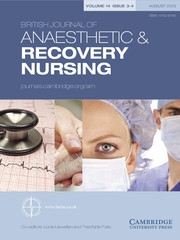Article contents
A Study into Postoperative Urine Retention in the Recovery Ward
Published online by Cambridge University Press: 12 December 2007
Extract
ABSTRACT
On the basis of hypothesis from our own practice, a study dealing with postoperative urine retention (PUR) in patients in the recovery ward was completed during 2006 in Odense University Hospital.
Three hundred and seven patients took part in the study with a view to monitoring the occurrence of PUR and to identify the relationship between risk factors and the development of PUR. Defining PUR as >300 mL in the bladder with the inability to urinate, the study showed that 28.7% of the patients had PUR at arrival to the recovery ward.
The study showed a positive correlation between patients with ascending age, rising anaesthesia duration, regional anaesthesia (RA) and developing PUR.
PUR occurred in half of the patients with diabetes and approximately half of the patients treated with ephedrine. Furthermore, the type of surgery had significance, as considerably more patients with plastic and orthopaedic surgery developed PUR. On the other hand, the study showed no correlation between subjective symptoms, e.g. like a strong desire to void, and the occurrence of PUR.
The results highlight the necessity for greater attention to screening patients for PUR.
- Type
- Education
- Information
- British Journal of Anaesthetic & Recovery Nursing , Volume 8 , Issue 4 , November 2007 , pp. 91 - 95
- Copyright
- © 2007 Cambridge University Press
References
REFERENCES
- 6
- Cited by


